Montreal’s public transport agency wants to focus on improving service
The Société de transport de Montréal revealed their 2016 budget on Nov. 19, just in time for the holiday season and its surprises. The Concordian sat down with Philippe Schnobb, Chair of the board in his office to talk about student concerns and the agency’s plans for the year to come. The interview has been translated from French.
This articles continues below.


The Concordian: We’ve noticed that students on the 105 Sherbrooke bus spend more time looking at buses in transit because the flow of buses goes the opposite way than the flow of students. Why is that?
Philippe Schnobb: The majority of our customers travel eastbound during the morning rush. When the 105 buses finish their journey, they continue on another route. It allows us to offer more service. We’ve added buses on the 105 last winter. Did it have undesired effects for Loyola students? I will ask that we make field observations.
C.: You’ve announced the addition of 45,000 hours of additional bus service. Will the 105 be a priority?
P.S.: This is precisely the kind of issue we aimed at correcting. We said we would add 150 to 200 trips per day* on the bus system. When we get iBUS up and running, we’re going to gather real-time and permanent data. An issue like this one will be easier to analyse and prevent.
C.: What’s the STM doing to improve its digitalization?
P.S.: The data gathered by iBUS will be open, which means any developer will be able to use it. When iBUS is implanted we’ll also release our own app which will replace the current STM app with real-time information.
C.: Do you have an ETA for this new system?
We have one but if I tell you and we can’t manage to release it on time you’ll say that we’re overdue (laughs).
C.: Why has it taken so long? Your predecessor already announced this system in 2010, 2012, 2013.
P.S.: What he’d announced was the beginning of the reflection on the project. But it’s a long process. Even before we’d started to do the concrete work to implement it, there’s been a waiting period which is not unusual.
C.: London has launched a similar system in 2005, other cities have followed. How do you explain that we’re a decade behind?
P.S.: Most cities started with a system that is very simple and they’ve adapted it to the evolutionary way of technology. We’re in 2016 and we’re coming from the Stone Age.
There have been issues with the integration of new technologies because it is more complex than before. This is why it took longer—but not that much. We’ve talked about this project for a very long time but it was never scheduled to be up and running before late 2014/early 2015.
It’s like the AZUR trains, we’ve talked about them since 2010.
C.: And when are we going to be able to ride those new metro trains?
P.S.: “Soon enough” is always the answer I give. We’re closer to it that when I arrived at the STM, for sure. We’re talking about early 2016 here, not the Saint-Jean-Baptiste.
It is necessary that the trains go through a series of tests made by the consortium [made of Bombardier and Alstom].
So that we can give the go-ahead, the trains have to reach certain performance goals, and this it is not yet the case. We’re not dealing with security issues, but it is in the interest of passengers and the STM that we take all the time it takes before saying yes, because once you say yes there’s no going back. And if there is a problem, you’ll be the ones caught in it during rush hour.
C.: Is the STM going to improve the metro service as well?
P.S.: We’re increasing the number of kilometres travelled by the metro this year. We’re planning on longer term to have a greater frequency, but it depends on several factors.
C.: Like funding?
P.S.: Not necessarily funding, the workforce also. But adding kilometres is a good investment because it moves a lot of people. A train carries just over 1,000 people. So it’s worth considering it. The new trains will nonetheless give us a greater capacity and more trains on the tracks.
C.: Can we hope for an all-night metro service or extended operating hours?
P.S.: The issue we’re facing today is the need to rebuild the metro system after more than 50 years [of existence]. The metro is an anthill during the night because we have maintenance work every night.
C.: Other cities manage to do it—London is launching a 24-hour service, Paris is planning on it as well.
P.S.: Their system is more extended and some cities have parallel lines which may help. In Montreal we are really in the middle of a major maintenance phase, we’ve spent $3.6 billion during the past 13 years and we’re going to spend almost $3 billion in the next three years. We want to offer a reliable service during the day. That’s why we’ve developed bus routes alongside the metro system.
This interview has been edited for length and clarity.
*A previous version of this article stated that the STM would add 200 to 250 trips per day when it should have been 150 to 200 trips per day. We regret the mistake.




